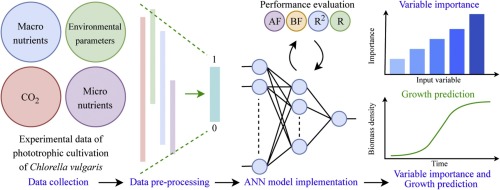当前位置:
X-MOL 学术
›
J. Biotechnol.
›
论文详情
Our official English website, www.x-mol.net, welcomes your feedback! (Note: you will need to create a separate account there.)
Development of an artificial neural network model to simulate the growth of microalga Chlorella vulgaris incorporating the effect of micronutrients.
Journal of Biotechnology ( IF 4.1 ) Pub Date : 2020-02-22 , DOI: 10.1016/j.jbiotec.2020.02.010 Vinoj Chamilka Liyanaarachchi 1 , Gannoru Kankanamalage Sanuji Hasara Nishshanka 1 , Pemaththu Hewa Viraj Nimarshana 2 , Thilini Udayangani Ariyadasa 1 , Rahula Anura Attalage 2
Journal of Biotechnology ( IF 4.1 ) Pub Date : 2020-02-22 , DOI: 10.1016/j.jbiotec.2020.02.010 Vinoj Chamilka Liyanaarachchi 1 , Gannoru Kankanamalage Sanuji Hasara Nishshanka 1 , Pemaththu Hewa Viraj Nimarshana 2 , Thilini Udayangani Ariyadasa 1 , Rahula Anura Attalage 2
Affiliation

|
Artificial neural network (ANN) models can be trained to simulate the dynamic behavior of biological systems. In the present study, an ANN model was developed upon multilayer perceptron neural network architecture with 23-20-1 configuration to predict the cell concentration of microalga Chlorella vulgaris at a given time. Irradiance level, photoperiod, temperature, air flow rate, CO2 percentage of the air stream, initial cell concentration, cultivation time and the nutrient concentrations of the media were considered as the input variables of the model. Resilient backpropagation learning algorithm was used to train the model by means of 484 experimental data belonging to four studies. Bias and accuracy factors of the developed model fall into the range of 0.95-1.11 indicating the model has an excellent prediction ability. Parity plot showed a good agreement between the predicted and experimental values with R2 = 0.98. Relative importance of the inputs was evaluated using Garson's algorithm. The results of the study indicated that CO2 supply had the highest impact on the growth of C. vulgaris within the selected range of input parameters. Among macronutrients and micronutrients, highest influence was demonstrated by nitrogen and copper respectively.
中文翻译:

人工神经网络模型的开发,以模拟结合了微量营养元素的微藻小球藻的生长。
可以训练人工神经网络(ANN)模型来模拟生物系统的动态行为。在本研究中,在具有23-20-1构型的多层感知器神经网络架构上开发了一个ANN模型,以预测给定时间的微藻小球藻细胞浓度。模型的输入变量是辐照度,光周期,温度,空气流速,气流中的二氧化碳百分比,初始细胞浓度,培养时间和培养基中的营养物浓度。弹性反向传播学习算法被用于通过属于四个研究的484个实验数据来训练模型。所建立模型的偏差和精度因子在0.95-1.11范围内,表明该模型具有良好的预测能力。奇偶校验图显示预测值和实验值之间的良好一致性,R2 = 0.98。使用Garson算法评估了输入的相对重要性。研究结果表明,在选定的输入参数范围内,CO2的供应对寻常小球藻的生长影响最大。在常量营养素和微量营养素中,氮和铜的影响最大。
更新日期:2020-03-07
中文翻译:

人工神经网络模型的开发,以模拟结合了微量营养元素的微藻小球藻的生长。
可以训练人工神经网络(ANN)模型来模拟生物系统的动态行为。在本研究中,在具有23-20-1构型的多层感知器神经网络架构上开发了一个ANN模型,以预测给定时间的微藻小球藻细胞浓度。模型的输入变量是辐照度,光周期,温度,空气流速,气流中的二氧化碳百分比,初始细胞浓度,培养时间和培养基中的营养物浓度。弹性反向传播学习算法被用于通过属于四个研究的484个实验数据来训练模型。所建立模型的偏差和精度因子在0.95-1.11范围内,表明该模型具有良好的预测能力。奇偶校验图显示预测值和实验值之间的良好一致性,R2 = 0.98。使用Garson算法评估了输入的相对重要性。研究结果表明,在选定的输入参数范围内,CO2的供应对寻常小球藻的生长影响最大。在常量营养素和微量营养素中,氮和铜的影响最大。



























 京公网安备 11010802027423号
京公网安备 11010802027423号